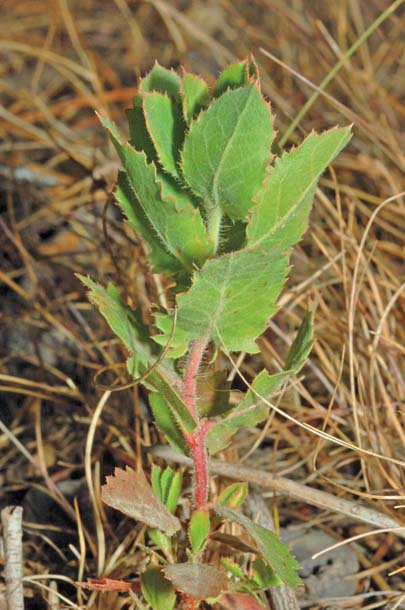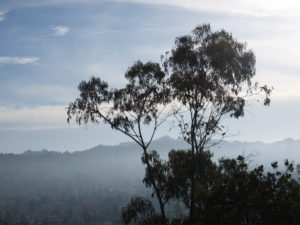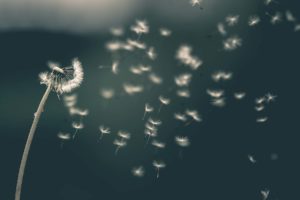I have spent much of my career anchoring the evening news wearing designer suits and heavy makeup. But now, I have a new occupation: I’ve traded in my microphone for a weed wrench, a fearsome tool the color of the Golden Gate Bridge. Instead of fancy suits I wear old work clothes more befitting a bag lady. I have, in fact, become the eccentric broom lady of East Ridge Trail. How did it come to this?
I grew up in Seattle, the daughter of a fisherman. I don’t mean that my father fished for a living; he just loved being out on the water at sunrise. I learned early on not to go with him because it meant hours of sitting in a boat with a group of men. But I inherited his love of nature nonetheless. If our family wasn’t on the beach, we were in the fields or the great forests of the Pacific Northwest. Dad taught us to pick mushrooms: elusive morels in the spring that could disappear in front of your eyes, chanterelles a little later in the season, and the prized matsutake in the fall. Wild, native blackberries and young bracken fern fiddlenecks also made their way from the forest to our kitchen. I loved it all.
- Tokuda discovered this baby pallid manzanita–a critically endangered species–in an area she’d cleared of broom. Photo by Wilde W. Legard, East Bay Regional Park District.
Dad made me my first bird feeder when I was seven years old–a flat plywood board, mounted on a post. But one of my favorite childhood moments was watching a large flock of birds attracted not by the feeder, but by the red berries of the adjacent hawthorne trees. I had never seen anything like it. There were so many flitting from branch to branch, it was as if the tree had come alive. I had no idea at the time what they were, though I later identified them from an encyclopedia photo: cedar waxwings. It was an exotic, singular, and memorable moment for a little girl in urban Seattle, but one of many such moments in my childhood. Even now, the smell of Douglas fir triggers a wave of emotion.
Years later, as a young woman, I was lured away from the Northwest by the offer of work in a bustling newsroom in California. I moved as close to the natural world as I could: a houseboat in Sausalito. The first morning there, I pulled open the drapes to see hundreds of ducks on Richardson Bay–pintails and canvasbacks and others I couldn’t identify. I had moved right onto the Pacific Flyway! My whole life in Seattle, I’d chauvinistically thought I’d been living in the most beautiful place on earth, but as I drove into work over the Golden Gate Bridge, I realized how narrow my vision had been. And yet, appreciating the stunning beauty of the Bay Area was very different from truly embedding in the natural world here, the way I had growing up in Washington. That commitment would take years.
My career in broadcasting took off and took over. I married a city boy, and we had two girls, who became urban creatures like my husband. Overwhelmed with my duties at home and work, I lost touch with that part of my life that had once been so central.
It wasn’t until the girls went off to college about eight years ago that I really began to reconnect with nature. Healing from a divorce, I began to explore the different parks in the East Bay Regional Park system. I saw my first meadowlarks in Wildcat Canyon, watched fish swim in a creek in Sunol, but eventually settled down at the park closest to home. It happened because of a weed.
It’s silent and shady in the canyons of Redwood Regional Park, where the trees grow so tall you can’t see the tops. On the upper trails you can look out and not see a single house; hard to believe you’re just minutes away from the gritty streets of East Oakland, so familiar to our news crews.
Hiking now frequently in Redwood, I began to notice a bright green leggy plant with cheerful yellow flowers taking over many of the trails, actually forming a canopy here and there. It was French broom, an exotic invader, and I could see that in some places it was creating a monoculture, squeezing out the native vegetation. Then one warm summer day, walking down the trail, I could actually hear the seed pods popping as I brushed against the branches growing into the trail. I stopped and noticed thousands of shiny black seeds on the ground, ready to start a new generation of plants. That did it. I called the park supervisor, Di Rosario, and asked if there was something I could do.
Di took me out to an area where the broom formed a shrubby wall next to the trail. He showed me how to use a weed wrench, as he explained what to pull and what to protect. We went out another time and cleared a good size stand. After he was confident I knew what I was doing, he loaned me a weed wrench. Only later did I realize how much trust was involved in letting this eccentric woman armed with a weed wrench loose in his park.
As someone who’d spent a career in television in the hectic atmosphere of the newsroom, I was surprised how satisfying it was to work alone and actually be able to see the physical result of my labor. I was quickly hooked. I added a small folding saw and Felco clippers to my tool repertoire and was thrilled to find that I could cut down 10-foot-tall bushes that were more like trees! I became a one-woman wrecking crew. I began spending more and more time in the park because I was enjoying it in ways I had never expected. My mind would clear. My back got stronger. Most important, I could see I was making a difference.
In between the monthly group efforts, I spend a lot of time in the park working on my own. I have come to know some spots there as intimately as my own garden. I have learned the names of the native plants one by one, like new friends. In some areas where I have cleared entire stands of broom, I return every year to pull out the inevitable seedlings and other weeds, and notice as the toyon and coffeeberry grow more robust. I know where the wild roses bloom and the yerba buena breaks fragrant under my feet. It’s turned me into a real Californian. This is home now.
Once in a while, something wonderful and unexpected happens. About a year ago, I was off the trail pulling broom when I noticed some seedlings unlike anything I’d ever seen at Redwood. But they looked like the young pallid manzanita plants I’d seen at the Friends of Sausal Creeks’ native plant nursery in nearby Joaquin Miller Park. Could that possibly be? Pallid manzanitas are a rare and endangered shrub found only in a few locations in the East Bay hills, so I knew this could be a big deal. My heart actually started to race. The seedlings were in an area that had been recently cleared of Monterey pines and eucalyptus; did the return of sunlight and warmth trigger their reemergence after decades of dormancy?
I called botanists from the park district and from the California Native Plant Society to check my hunch. Lech Naumovich of CNPS was excited but cautious. The district’s Wilde Legard took careful GPS measurements and photos. But the plants were too young to identify with any certainty. So, until the little plants could grow larger, it remained a quiet discovery, as are most of my moments in the forest. Only just recently, two years later, were the plants indeed positively identified as pallid manzanita.
Some of the unexpected pleasures have arrived on wings. I heard the pileated woodpecker before I saw it; it was a call I’d never heard before–loud, confident and raucous, echoing across the canyon. Then I saw it–there was no mistaking it–a large, gangly bird that looks like a cross between a pterodactyl and Woody Woodpecker. Several times since then I’ve been lucky enough to have one approach within 30 feet of where I’m working quietly off trail–so close I can easily watch it without binoculars. It jabs at the tree trunks looking for food, not with the poetic, rhythmic tapping of most woodpeckers but more like a jackhammer. Then all of a sudden, it flies off, threading its way through the trees.
Just this morning, I hiked deep down into the redwoods and thought about how lucky I am. I stretched my arms up toward the sky and let the wind blow through me.
To join the broom-removal efforts at Redwood Regional Park, call (510)482-6024 or email redwood@ebparks.org.

.jpg)





